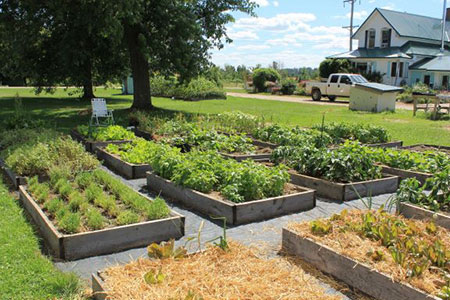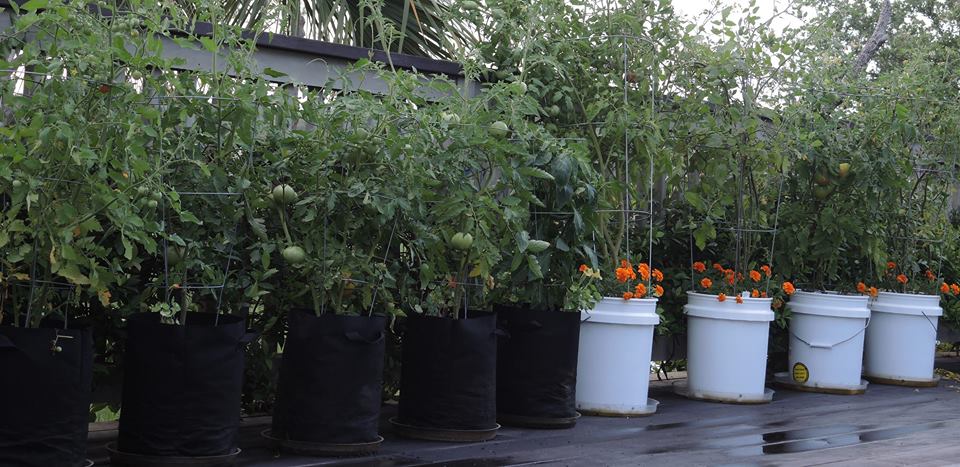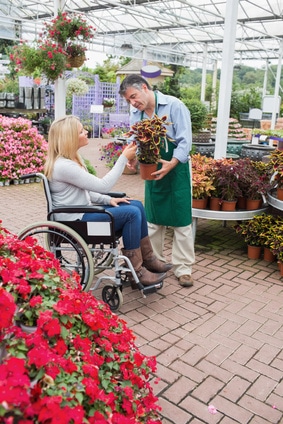What comes to your mind when you think of gardening? Many picture someone on their hands and knees, digging in the ground. This isn’t the only way you can enjoy a garden, though. Many people with different physical abilities can still get out in the garden!. The following resources may help you cultivate your green thumb in an accessible way.

Creating an accessible garden can be easily accomplished by following a few simple guidelines.
Step 1: Construction - Raised Beds or Containers
Consider a comfortable height at which to work, usually between 28 and 30 inches high. Width is also important, so that the beds are accessible from all sides. Ideally, the beds should be about 4 feet across, or 2 feet from any side to the center. Length is up to you-any size will do. Use pressure treated 2 x 8 with 4 x 4 posts for corners to construct your raised beds and fill with top soil or compost. Large pots also provide a nice alternative to raised beds. The pots are easily moved and can be reconfigured to your preference at any time.

Step 2: Choosing Paths
Grass is one option, but maneuvering a lawnmower may be difficult down narrow paths. Wood chips or mulch are also options. Use a thick layer to keep the weeds down and plan to replace every year or two. Keep in mind that wood chips may prove a difficult surface for wheelchairs. Pea gravel or large white marble is not a good choice for your path, as these would be hard to wheel through. Lastly, brick or stone patio can be used as a permanent path surface around the raised beds or containers. Both options will keep the weeds at bay, neither need to be replaced often and wheelchairs can easily maneuver these surfaces. However, these options can be more labor intensive and expensive to install.
 Step 3: Picking Plants
Step 3: Picking Plants
Now that you’ve built your garden and ensured accessibility, what should you plant? Either annuals or perennials will work. Choice annuals include petunias, marigolds, snap dragons, pansies, impatiens and annual salvia. Plant taller plants in the center or back of the bed and the shortest plants in the front. Perennial choices include black-eyed-susans, ornamental grasses, hostas, daisies, dwarf iris and creeping dianthus. Keep in mind that annuals, while beautiful and colorful, must be replaced each year while perennials take a few years to grow to full size, but require less attention after initial planting season.
Step 4: Keeping It Up - Maintenance
Once planted, your garden requires less frequent attention. Water your plants when dry in the morning or evening, not mid-day when the sun is hottest. Monthly, you should fertilize your garden, keeping it growing strong and providing lots of flowers and vegetables. Less frequently, you should prune your garden by taking off the old, dead flowers so the plants will continue to make new ones. Keep in mind that long-handled tools can make gardening tasks much easier!
Accessible gardening provides therapeutic benefits to many people. After weeding a row of flowers, you may have a renewed sense of energy. Or after an afternoon outdoors, you may feel more peaceful. Many have experienced the therapeutic benefits of horticulture; people all around the country enjoy retreating to the garden to relax as a way to renew their energy, create a sense of place, and regenerate their self-esteem.
Gardening Resources
To learn more about creating and maintaining your own accessible garden, visit www.accessiblegardens.com.
Also, you may want to follow Access to the Garden on Facebook. Access to the Garden is an awesome page devoted to making every garden, whether private or public, more accessible and usable by all people. This page will appeal to anyone with a disability, anyone getting older, or to anyone who enjoys gardening.
 About the Author: Katie J. Hogan is an experienced marketing professional in Atlanta, GA. She graduated from Auburn University with a B.S. in Business. When she’s not busy with marketing, Katie enjoys singing at local music events, competitive team trivia and spending time with friends and family.
About the Author: Katie J. Hogan is an experienced marketing professional in Atlanta, GA. She graduated from Auburn University with a B.S. in Business. When she’s not busy with marketing, Katie enjoys singing at local music events, competitive team trivia and spending time with friends and family.
I love the idea of using raised beds for accessibility. These would be great in retirement communities and extended-care hospitals. Thank you for the tips!